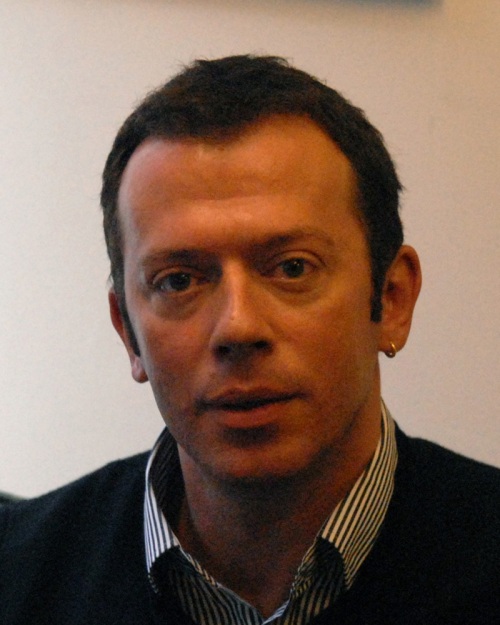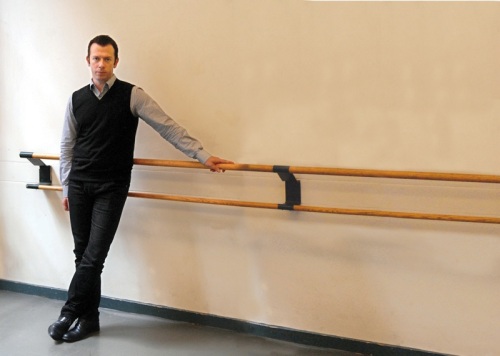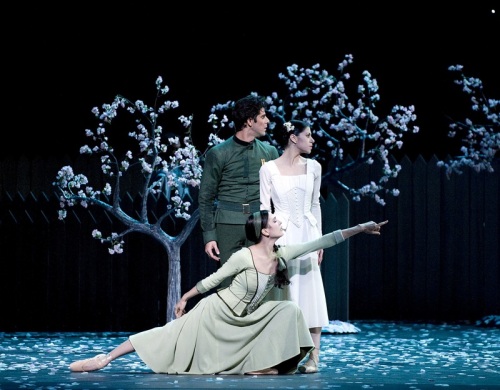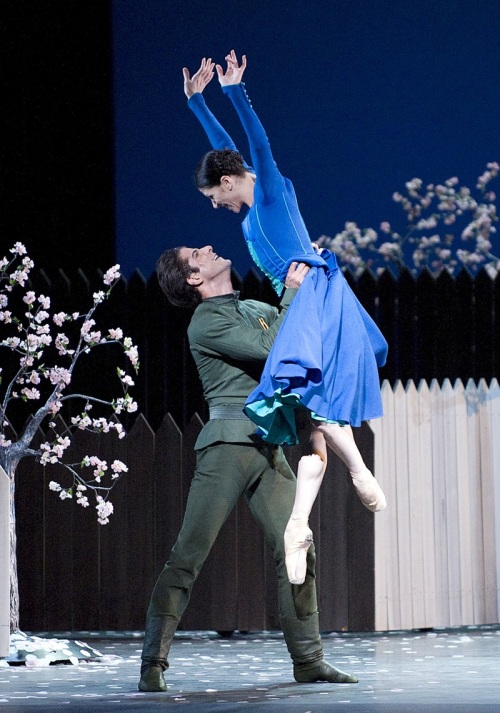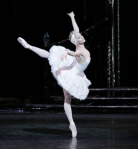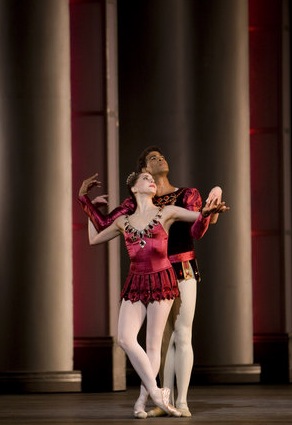
Veronika Part. Source: ABT. Copyright Ballet Theatre Foundation ©.
On one side her admirers and knight-in-shining-armour defenders. On the other those who see her as an inconsistent performer. It doesn’t matter on which side one stands, all this debate has helped American Ballet Theatre‘s newest Principal dancer Veronika Part become the equivalent of a ballet cross-cultural phenomenon. Other than achievements such as her success whilst still a soloist-doing-principal roles, being hailed by London critics in the most recent ABT Coliseum season and forming together with ABT guest artist Roberto Bolle one of Ballet’s most picture perfect partnerships, Veronika has also managed to electrify jaded ballet-goers, bring new audiences into the theatre, and bag an invitation to The Late Show with David Letterman, one of the US’s hottest talk shows, giving ballet a much needed mainstream boost, charming audiences with her grace and personality, not to mention her gorgeous face.
Londoners had the pleasure of seeing Veronika last March before her promotion to Principal dancer. She performed here amid rumours that she might be leaving the company in the absence of an overdue promotion. The British critics fell under her spell and she wowed me too: watching Veronika as one of the three odalisques in ABT’s Le Corsaire, it was not only clear that she outshined the other two women (ABT soloists Maria Riccetto and Kristi Boone), but she also commanded the stage like few do. It was no surprise to learn shortly after Part’s London stint that she had finally been promoted.
Product of the Vaganova machine, Veronika exhibits all the traits that are so distinctive in Russian dancers: wonderful port de bras, a musical and plastic upper body, regal and elegant lines. She might not be so much the technical whiz as some of her ABT colleagues (like Gillian Murphy, Paloma Herrera or Michelle Wiles), nor did she get to the top as fast as her former classmates Svetlana Zakharova and Daria Pavlenko, however, as a tallish (5’8” = 1.72 m) womanly bodied dancer, she knows how best to use her physical gifts to convey artistry: she makes you feel Odette’s pain, follow Odile’s flirtatious face and make the audience, rather like prince Siegfried, forget about everyone else on stage.
The best description I found of what Part brings as a dancer and why she has gathered so many admirers is by Tony Mendez, a former professional ballet dancer, turned guest finder for Letterman, who is, of course a huge Veronika fan:
Inconsistency kind of gives a dancer an edge. When I go and see Gillian (Murphy) and Paloma (Herrera), I know they’re going to be perfect… So when I see Veronika Part, there’s a little more of a human thing about her—you don’t know how well she’s going to do, and when she does really well, it’s exciting. And her beauty onstage— she’s beautiful to look at. I don’t think that Veronika Part looks like a ballerina. She looks like a beautiful woman who dances.
Veronika Part in a Nutshell
Born in St. Petersburg, 1978 into a family with no ballet connections. A nurse mentioned to her mother that she had pretty and long legs, so she might make a great ballerina, though before taking up ballet, Veronika trained in artistic gymnastics.
She started ballet at age 10 after being accepted at the famous Vaganova Academy to study under the guidance of Inna Zubkovskaya.
Veronika graduated in 1996, joined the Mariinsky as a member of the corps de ballet and was promoted to Soloist in 1998. Her first major role was Myrtha in Giselle, which she danced just months after having entered the company (January 1997).

Veronika Part as Myrtha. Source: Broadwayworld.com. Copyright belongs to its respective owners.
Coached by Gabriella Komleva she danced her first principal role: Swan Lake’s double act of Odette/Odile, but her favourite classical role is actually Raymonda, where she drew favourable comparisons with former teacher (and coach for the role) Inna Zubkovskaya.
In 2002, during a Mariinsky tour to New York where she received glowing reviews for her performances as the second soloist in Balanchine’s Emeralds, Veronika accepted Kevin McKenzie‘s invitation to stay in the US and join ABT as a Soloist.
Veronika has mentioned several times that those initial years in NY, with no friends or family, made her a stronger person. Word is that she learned English while watching episodes of the popular TV series Seinfeld.
A string of uneven performances in 2006/2007 (including Nikiya in ABT’s 2007 Paris Tour) prompted much discussion about Veronika’s stamina, technique, and whether or not nerves were getting in the way, reviews shifting between positive and negative from one season to the next (For instance, this review by Alexandra Tomalonis and this one by Gay Morris, both from Danceviewtimes).
Her big break with ABT happened in 2007, when she was cast as Aurora in the opening night of the McKenzie/Kirkland/Chernov new production of The Sleeping Beauty. Although she still got mixed reviews for this notoriously challenging role and some questioned her technical suitability for it, she generally started to get more attention in soloist and principal roles alike.
Despite the overall good reviews and an ever increasing fanbase, ABT still seemed reluctant to give her a promotion or to throw more principal roles at her (besides Odette/Odile, Nikiya and the Sugar Plum Fairy), so rumours were that she would leave in 2008. Luckily for her fans this never materialized and it is thought it was perhaps the appointment of Alexei Ratmansky as ABT’s resident choreographer which contributed to Veronika’s change of heart.
Veronika performed Odette/Odile during ABT’s London tour to outstanding reviews, rekindling the debate amongst critics and audiences about her overdue promotion. Veronika was finally made a Principal dancer in April 2009.
She is often partnered by Marcelo Gomes a tall, handsome dancer and a good match for her physique. Recently she also found another match for her “in looks” as a much commended sold out performance of Swan Lake alongside Roberto Bolle was labeled by avid fans “the best looking partnership in the history of ballet”.
Veronika is a spokesperson for Gaynor Minden Inc. and a wearer of their pointe shoes since 2002.

Veronika Part and Marcelo Gomes in La Bayadere. Photo: Gene Schiavone/ABT ©. Source: Danceviewtimes
Videos
- A very young Veronika dances a Fairy Variation [link]
- 1992’s 4th Year class of the Vaganova Academy. We can see her taking class together with future Mariinsky Star Daria Pavlenko. [link]
- Veronika’s recent appearance in The Late Show with David Letterman [link]
- Part dances the lead role in the Mariinsky’s production of Raymonda. Performance videos, parts 1 [link] and 2 [link].
- Veronika as Odette with Marcelo Gomes as Siegfried in ABT’s Swan Lake. [link]
Extract of Reviews and Praise
Of her Odette/Odile
Ms. Part, whose clean style is tinged with an intriguing blend of languor and voluptuousness (…). She offered a superbly tender and sad Odette. With eyes down, lips parted and head thrown back, she evoked a spellbound princess. Her adagio in Act II was conventionally lyrical in the best sense: she wreathed Mr. Korsuntsev’s head with her arm with the softness that colored all her gestures. Yet sharply bent forward, she was a swan maiden with a broken wing, wounded by love and fate. Anna Kisselgoff at the NYTimes [link]
Ms. Part’s performance is always about the irreducible structural components of classical ballet. She pruned away mannerism as much as is possible or desirable to do an art form that is itself somewhat manneristic. She was technically sound, but her “Swan Lake” was not technical acrobatics; nor was it about realistic drama or animal imitation. She preserves the stylistic imprint of the role without a lot of flapping or pecking. She maintains a rare equilibrium between the linear and sculptural elements of classical ballet. Joel Lobenthal at the NYSun [link]
Veronika Part, with her broad-shouldered Joan Crawford looks, gave the most assured and intense performance I have seen from her in a major ballerina role. Her Odette, full of yearning backbends, is awash with feeling; her Odile glamorously exultant. Alastair Macaulay at the NYTimes [link]
Part offers dancing and interpretation of a voluptuous grandeur, Odette’s tragedy saturating movement and pose, Odile’s malevolence an intoxication of the spirit that will dazzle Siegfried utterly. The role is luscious in phrasing, ever expressive, true. Clement Crisp at the Financial Times [link]
Of her debut as Nikiya in ABT’s La Bayadère (May 2007)
Ms. Part is a great adagio technician, perhaps the greatest in Kirov lineage since Natalia Makarova and Alla Osipenko 40 years ago. During her lamenting variation in the Pas d’Action… we saw a marvel of scale, ease, and refulgence. No one onstage today better demonstrates the Russian ideal of movement originating from the back, radiating to the extremities and beyond… She is part of an epic ballet spectacle, and her outpouring of emotion is as lush and grand as her physical production. Joel Lobenthal at the NYSun [link]
and of a more recent performance of the same role (2008)
Ms. Part is a highly individualistic dancer who represents several traditions in addition to her own individuality. She epitomizes the Russian emphasis on legato movements, a bel canto all its own… Very few others have succeeded artistically as well as Ms. Part. She lets her height and flexibility expand, but not traduce, the architecture and poetics of classical ballet; her taste is exemplary. Joel Lobenthal at the NYSun [link]
Nikiya the temple dancer – or bayadere – was the St. Petersburg-born Veronika Part, dancing with poignant eloquence and impeccable style. Clive Barnes at the NYPost [link]
Of her roles in The Sleeping Beauty:
First, as Aurora
Veronika Part’s lush, emotionally eloquent dancing as Aurora in the Vision Scene was the sole unarguably wonderful element in ABT’s new version of “The Sleeping Beauty”…The Kirov-trained ballerina’s work in the arduous first act had been admirably strong and clear. But here — seemingly impalpable, yet making it clear that she is longing for the Prince as much as he is for her — Part worked the real ballerina magic of transforming steps into atmosphere and feeling. Tobi Tobias at Bloomberg [link]
and as the Lilac Fairy
She (Part) reclaimed her rightful role as the Lilac Fairy, for which she’s perfect and in which she has lengthy experience. Ms. Part danced and declaimed magnificently. As exciting as the sweep and aplomb of her movement were the many shades of character she brought to the role, appropriate for a deity who should ideally encompass all the attributes that are presented to the infant Aurora in the Prologue by Lilac’s attendant fairies. Joel Lobenthal at the NYSun [link]
Clement Crisp comments on Part’s various appearances in London:
Balanchine’s Symphonie Concertante
…The corps was nattily exact, much given to eager smiles as if trying to jump a queue, and it was the presence of Veronika Part (as the viola’s representative) who brought the piece, and the evening, to glory. We remember her as a young divinity with the Mariinsky Ballet and the dignity and amplitude of her St Petersburg style, the voluptuous, luscious grace of her every action, pouring some noble and heady wine for us, breathed life, meaning, into her role. She was a diamond set amid rhinestones, Pouding Nesselrode as an alternative to water ices. Clement Crisp at the Financial Times [link]
and as one of the three Odalisques in Le Corsaire, last March:
Veronika Part appeared, a divinity in exile, as an odalisque. Clement Crisp at the Financial Times [link].
Sources and Further Information
- Veronika Part’s Official Website [link]
- Profile for Kirov Ballerina Veronika Part by Marc Haegeman, from For Ballet Lovers Only [link]
- Gaynor Minden Dancer Profile, written by Eliza Minden and Karen Lacy [link]
- Veronika Part interviewed by Graham Watts. Ballet.co Magazine, March 2008 [link]
- A Reason to Go on Living, blog post by James Wolcott. VanityFair.com [link]
- Assoluta by Laura Jacobs. Dance critic for The New Criterion [link]

Read Full Post »


